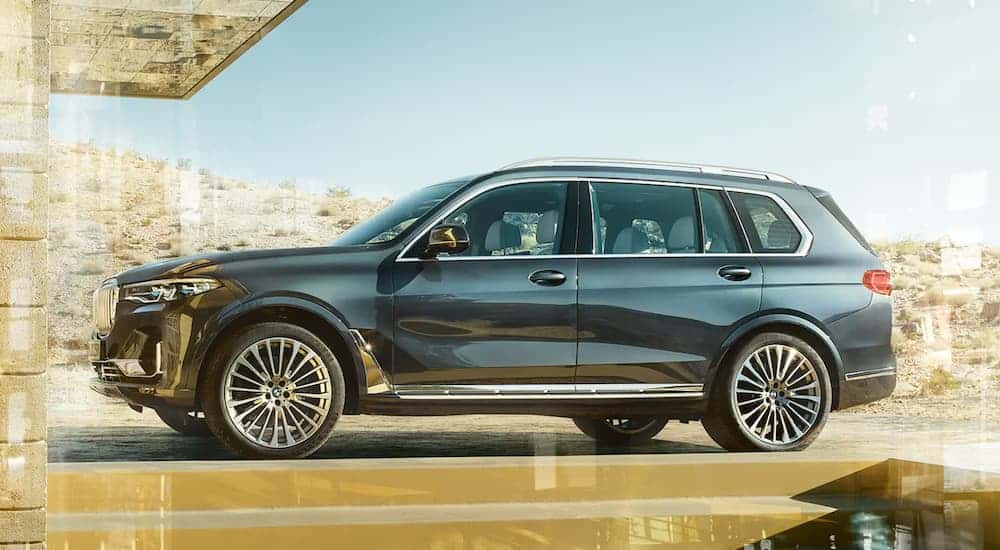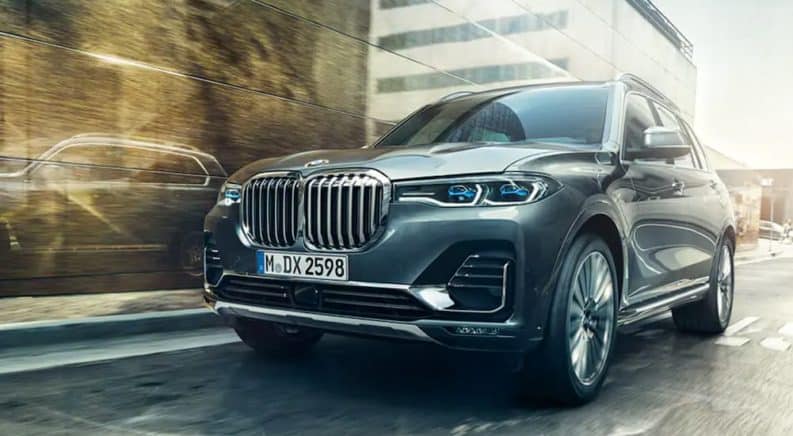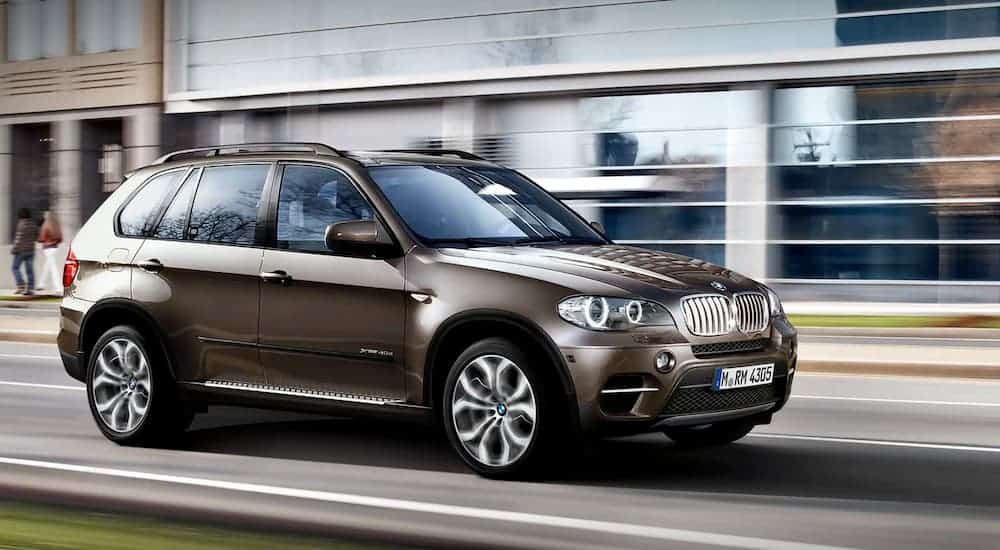The BMW X7, first introduced for the 2019 model year, is the largest BMW ever built. While BMW experienced great success with the original BMW X5 Sports Activity Vehicle and has spent years adding numerous smaller and sportier SUVs to its lineup, it was seemingly reluctant to expand its offerings to include larger vehicles. This may have been out of fear that anything more massive than the BMW X5 would no longer be able to offer the trademark BMW performance and handling. Still, eventually, BMW acknowledged the popular demand for something larger than the BMW X5 and introduced the BMW X7. But what exactly are the differences between the two? Today we are going to find out with a comparison: BMW X7 vs BMW X5.
Overall, the BMW X7 does live up to its promise of being a larger and more luxurious vehicle. With significantly more interior space and its standard three rows of seats, the BMW X7 challenges a new market segment for BMW. However, while the size of the new vehicle is impressive, it does hinder performance to some extent, and the BMW X7 is slower than the BMW X5. Still, this performance difference is small, and BMW’s engineers have done their best to make the larger vehicle handle just as well as any of their other designs. In the end, the additional size and luxury of the BMW X7 allow it to compare well to the smaller and perhaps sportier BMW X5. But this is all base-level information; let’s take a more in-depth look at these two SAVs and how they compare.
Size Does Matter
The largest difference between the BMW X7 and the BMW X5 is, of course, their size. Prior to the introduction of the BMW X7, the BMW X5 was the largest SUV in the BMW lineup. However, designed with two rows of seats for five passengers and just 72.3 cu.ft. of cargo space, the BMW X5 was still on the smaller side, even compared to other two-row SUVs on the market. It is likely that, in the past, many families and even individual drivers who were interested in a BMW were forced to look at other manufacturers simply because the BMW X5 lacked the space they needed for their lifestyles.
With the introduction of the BMW X7, that is no longer the case. Some 9” longer and over 2” taller overall than the BMW X5, the BMW X7 offers three rows of seats for a total of seven passengers and 90.4 cu.ft. of cargo space. And the extra height of the X7 even allowed it to increase the front row headroom by over an inch. While BMW still might not have the largest SUV on the market, the BMW X7 is more than large enough to handle the needs of nearly any driver.

But Smaller May Be Sportier
While the BMW X7 is a much larger vehicle than the BMW X5, it is not a more powerful one. In fact, it shares the same exact engine options as its smaller counterpart. All three of these engines are BMW’s TwinPower turbos, with the base 3.0L inline-six engine producing a respectable 335 hp and 330 lb-ft of torque, while the optional 4.4L V8 has an excellent 456 hp and 479 lb-ft of torque. The top engine is only available on the M Performance versions of these vehicles. It is a more powerful variant of the 4.4L V8 that has had its output significantly increased to 523 hp and 553 lb-ft of torque.
None of these engines can be described as underpowered, and even the base engine will propel the BMW X7 from 0 to 60 miles per hour in 5.8 seconds. However, as can be expected of a much heavier vehicle with the same amount of power, the BMW X7 is slower off the line than the BMW X5 and on average takes around an extra half-second to reach 60 miles per hour. Still, it is somewhat doubtful whether that difference will be meaningful to the ordinary driver shopping for a three-row SUV. And with a 4.5 second 0 to 60 time in its top trim, the BMW X7 is still blistering fast for a vehicle weighing close to three tons.
Similar, But Not The Same
Aside from sharing the same engines, the BMW X7 and BMW X5 are very similar mechanically. However, there are some notable differences. One of the largest is that while the BMW X5 is available as a rear-wheel drive vehicle, the BMW X7 is only sold with the BMW xDrive all-wheel drive system. Still, the rear-wheel drive option is only available with the base engine of the BMW X5, and the xDrive system is designed with a rear-wheel bias to maintain the traditional BMW driving dynamics.
Another more subtle mechanical difference is that the BMW X7 rides on larger 21” or 22” wheels instead of the standard 19” or 20” wheels of the BMW X5, and uses wider tires with thinner sidewalls. Such changes usually result in sportier handling but at the cost of some comfort. The decision to use such a configuration on the BMW X7 may have been made as part of the effort to allow such a large vehicle to offer the ultimate driving experience expected of a BMW product.
Finally, although the BMW X7 and the BMW X5 share the same modern eight-speed automatic transmission, the BMW X7 has a larger 3.39 final drive ratio instead of the 3.15 ratio found in the BMW X5. While the effect of this change is small, it does help give the larger vehicle a boost and is another example of the engineering BMW put into designing their largest vehicle to date.
Larger And More Luxurious
While both the BMW X7 and the BMW X5 are incredibly luxurious vehicles when fully equipped, the BMW X7 offers a broader array of standard features as well as a couple of new features of its own. Unlike in the BMW X5, all trims of the BMW X7 come standard with some reasonably major items to enhance driving comfort. Perhaps the largest of these is the air suspension system that will lower the car either automatically at high speeds to reduce air resistance or at the push of a button when stationary to ease loading and unloading. It will also level the vehicle both front to back and side to side to balance asymmetric loads. Another standard feature on the BMW X7 is four-zone automatic climate control. This allows the second-row passengers to adjust the climate the way they want it, while the BMW X5 only gives the front row that choice without adding optional equipment.
And as befits BMW’s first standard three-row SUV, the BMW X7 also has two all-new options to take advantage of its greater interior space. The first of these is an available five-zone automatic climate control system that gives even the third-row passengers their own independent temperature settings. The second new feature is the option to replace the second-row bench seat with captain’s chairs. While this does reduce seating capacity from seven to six, it brings greater second-row comfort and improved third-row accessibility. Altogether, this additional standard and optional equipment helps make the BMW X7 not only BMW’s largest vehicle to date, but also it’s most luxurious.
So, Is Bigger Better?
If you need more space, the X7 is definitely the better choice. And not only is there more space in the X7 than in the X5, but the inside is more luxurious as well. On the other hand, though, the X5 is sportier and has the same performance offerings as its larger cousin. Overall, it all depends on what you need in a vehicle. So is bigger better? Sometimes.





